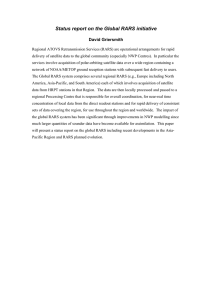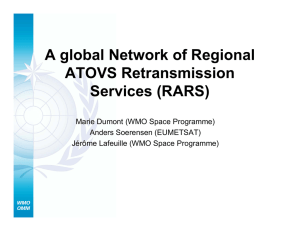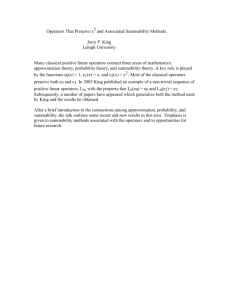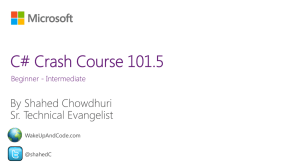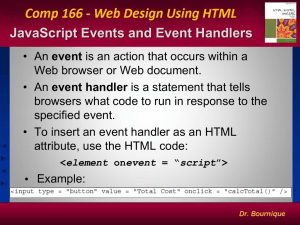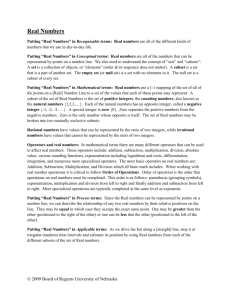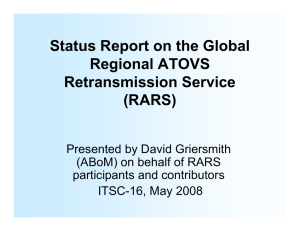List of conclusions
advertisement
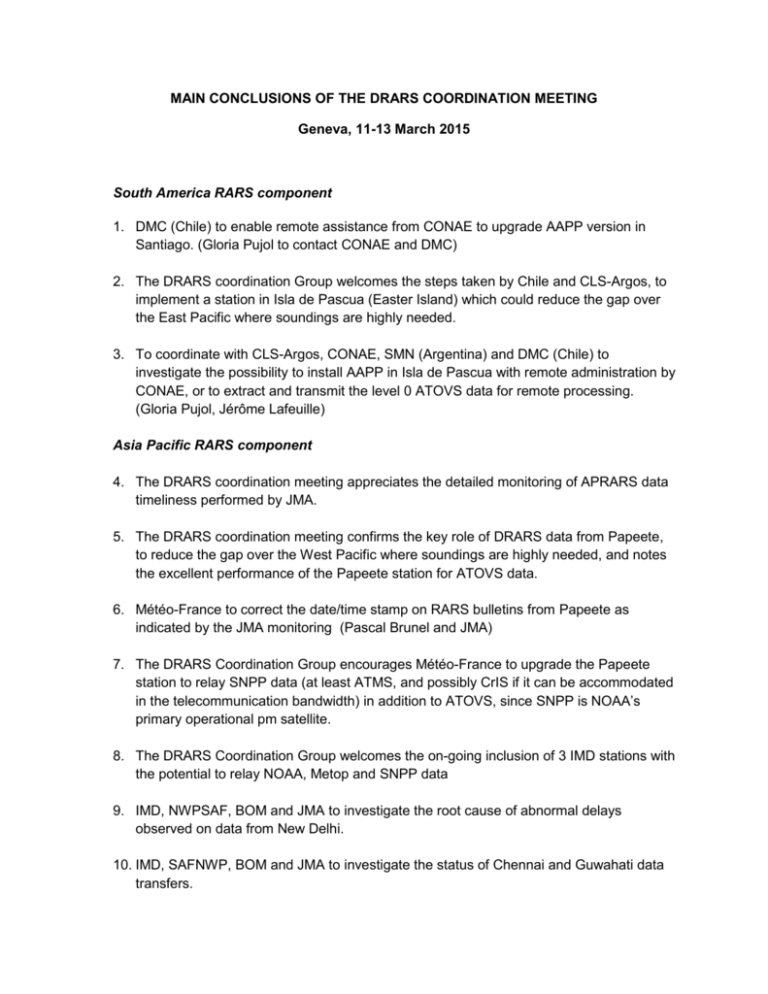
MAIN CONCLUSIONS OF THE DRARS COORDINATION MEETING Geneva, 11-13 March 2015 South America RARS component 1. DMC (Chile) to enable remote assistance from CONAE to upgrade AAPP version in Santiago. (Gloria Pujol to contact CONAE and DMC) 2. The DRARS coordination Group welcomes the steps taken by Chile and CLS-Argos, to implement a station in Isla de Pascua (Easter Island) which could reduce the gap over the East Pacific where soundings are highly needed. 3. To coordinate with CLS-Argos, CONAE, SMN (Argentina) and DMC (Chile) to investigate the possibility to install AAPP in Isla de Pascua with remote administration by CONAE, or to extract and transmit the level 0 ATOVS data for remote processing. (Gloria Pujol, Jérôme Lafeuille) Asia Pacific RARS component 4. The DRARS coordination meeting appreciates the detailed monitoring of APRARS data timeliness performed by JMA. 5. The DRARS coordination meeting confirms the key role of DRARS data from Papeete, to reduce the gap over the West Pacific where soundings are highly needed, and notes the excellent performance of the Papeete station for ATOVS data. 6. Météo-France to correct the date/time stamp on RARS bulletins from Papeete as indicated by the JMA monitoring (Pascal Brunel and JMA) 7. The DRARS Coordination Group encourages Météo-France to upgrade the Papeete station to relay SNPP data (at least ATMS, and possibly CrIS if it can be accommodated in the telecommunication bandwidth) in addition to ATOVS, since SNPP is NOAA’s primary operational pm satellite. 8. The DRARS Coordination Group welcomes the on-going inclusion of 3 IMD stations with the potential to relay NOAA, Metop and SNPP data 9. IMD, NWPSAF, BOM and JMA to investigate the root cause of abnormal delays observed on data from New Delhi. 10. IMD, SAFNWP, BOM and JMA to investigate the status of Chennai and Guwahati data transfers. 11. IMD is encouraged to participate in APSDEU-NAEDEX and inform this group of the possibility to distribute INSAT-3D sounding data. 12. CMA is encouraged to share on the GTS, in a format consistent with global data in BUFR, the FY-3 sounding data from Beijing, Guangzhou, Urumqi which are concentrated in Beijing. 13. The status of FY-3 VASS data coding and formatting to be reviewed by NWP SAF Cross-cutting matters 14. The DRARS Coordination Group thanks the NWPSAF (Nigel Atkinson) for the global monitoring of RARS data and his support to AAPP users. 15. EUMETSAT to streamline the procedure for making the IASI configuration files available. 16. The DRARS CG requests the CGMS satellite operators to ensure the early availability of L0/L1 processing packages for upcoming satellite systems, including FY-3D/E, JPSS, METOP-SG, at least for all instruments that are relevant for DRARS. In particular, CMA is invited to provide processing package for MWRI. 17. All station operators should update the TLE at least once per day – knowing that significant changes can appear after a satellite manoeuvre. NWPSAF should address this point more precisely in AAPP documentation, with sufficient details on the information sources to be relied upon. 18. The importance of frequent update of precise orbital elements should be brought to the attention of CGMS satellite operators, in particular upon orbit manoeuvres. 19. Station operators are encouraged to give higher priority to NOAA-18 than NOAA-15 in reception scheduling. Transition to DRARS 20. NOAA: The RARS CG highly appreciates the DBRTN project which is expected to become a major component of the future DRARS and considerably expand the coverage in X-Band services, through close cooperation between NOAA and EUMETSAT. 21. NWPSAF (Nigel Atkinson) to further investigate the apparent discrepancy between the BUFR implementation required by NCEP and the AAPP BUFR formats for CrIS and IASI, with a view to achieve full interoperability within the DRARS community. 22. The DRARS Coordination Group notes that GNSS-RO requires precise orbit determination, which is not available in real time, therefore GNSS-RO is not currently considered as candidate for a future DRARS Service. 23. All DRARS products should be registered in WIS (directly with a GISC or through a DCPC) and in Vol.C1 as mentioned in the draft Guide. The BoM (Anthony Rea, as AP RARS coordinator), will share its experience of registering RARS products in WIS, in order to assist interested DRARS contributors. Guidance to update the Metadata and keywords will be given by the CGMS Task Team on Discovery Metadata at CGMS-43 (May 2015), which should help describe all DRARS products in a consistent way in WIS. 24. The DRARS Coordination Group should work with APSDEU-NAEDEX (next meeting in Montreal in Oct. 2015) to jointly formulate a request for data exchange through the WIS, specifying: o o o o o List of NWP centers requesting to receive the data (possible evolution with time) Data originating centers, i.e. DRARS operators (though this end of the chain is probably not the most critical) Typical file sizes When and how often the data need to be exchanged (assuming a certain satellite configuration) Timeliness requirement (as recorded in the DRARS high-level specification). A simulation tool developed by WMO (Jérôme Lafeuille) after RARS-IG6 evaluates the variation of the data flow generated by a DRARS network over a 24 hour cycle. Since the data exchange needs will evolve along the years, the request should include a multiyear evolution. CGMS question on X-Band transmission polarization 25. The CGMS-WG I requested feedback from the DRARS community about the possible use of LHCP polarization instead of RHCP polarization for some X-Band Direct Broadcast services. The fact is that there is an increasing risk of interference in X-Band where the meteorological satellites are using the same frequency range. In order to mitigate this risk, CMA is using LHCP polarization on FY-3C and has announced the intention to use LHCP on every other spacecraft of the FY-3 series in the future while RHCP is traditionally used so far on all meteorological satellites. 26. Assuming that every other FY-3 spacecraft as of FY-3E is launched at an early morning ECT, the early morning satellites would thus have LHCP while all afternoon satellites would have RHCP. If they used the same polarization, interference among these two series could have occurred at high latitude (80°) only in case of simultaneous overpass. With two different polarizations, the group noted that users would normally not be able to receive all satellites on the same antenna, unless the polarization is made configurable on their receiving system. This issue would be critical with FY-3E , which is planned to transmit all data in X-Band only, tentatively in LHCP. 27. In order to evaluate the impact on the user side, all station operators should be asked to indicate the type of receiving station they are operating and should investigate the feasibility of adapting their station to make the polarization configurable (LHCP/RHCP) to be able to acquire future FY-3 Direct Broadcast. Feedback should be consolidated by WMO, on behalf of the DRARS Coordination Group and reported to CGMS-43 WG I. The RARS regional/subregional coordinators should send enquiries before end of March, requesting answers by mid-April, copied to WMO. 28. As a rule, satellite operators should provide details on DB services several years in advance of new systems, including for instance frequency, polarization, encoding, G/T requirements, conformance with CCSDS. Processing Software issues 29. All Station operators are encouraged to provide feedback to processing software providers, including e.g. on suggestions to facilitate upgrades. 30. DRARS station operators must have functional and up-to-date versions of the relevant processing software, including AAPP , CSPP (for SNPP), and FY3PP (for FY-3), and must have the computer hardware, technical expertise, and networking to make it possible for them to run the current versions of AAPP, CSPP, and FY3PP. There is no guarantee, however, that all Operators use the current version of AAPP. For SNPP, there is no evidence that station Operators will have a Linux system with sufficient CPU, RAM, and hard drive resources, and a CentOS 6 host platform to run CSPP. There is also the risk that they don’t have technical expertise to install, operate, and maintain CSPP, or that their processing systems/software was provided by vendors who can only perform updates at high cost. 31. The DRARS Coordination Group recommended: (1) to survey the DRARS operators to find out what version of AAPP, CSPP, FY3PP they are using, whether they have expertise to upgrade/install AAPP, CSPP, or FY3PP , what computer hardware (CPUs, RAM, Hard drive), operating system, and network connection and bandwidth they have. 32. Based on the output from the DRARS operator survey, some or all of the following items could be pursued by the software providers: (i) Provide minimum recommended specifications for computer hardware and network in order to run AAPP, CSPP, and FY3PP; (ii) Create detailed instructions on how to install and run processing software stacks for NOAA ATOVS, Metop ATOVS, IASI, CrIS/ATMS, VASS, this would include best practices for TLEs, calibration lookup table updates, etc.; (iii) Create automated installation and verification scripts for AAPP and OPS-LRS; (iv) Provide an automated light-weight processing system for AAPP, CSPP, or FY3PP. 33. Furthermore the DTARS Coordination Group recommended to investigate ways to make it possible for DRARS operators to contribute sounder data to the network without needing to run local processing: (i) Provide a mechanism where station operators can notify a regional coordinating node that Level 0 data is available; (ii) Provide a mechanism to allow push or pull of the Level 0 data (perhaps in compressed format) to the regional node; (iii) Regional node can process the data to Level 1 and BUFR and distribute it normally via GTS/WIS/Rebroadcast/Internet; (iv) Provide the regional or global data back to the station operator (if needed). Draft Guide to DRARS 34. A revised version of the Draft Guide to DRARS was produced, incorporating the outcomes of the two breakout groups. It was agreed that the structure of the document should be adjusted in order to address respectively: description of DRARS; control processes, common production processes; service specific production processes; and annexes. 35. The breakout group on Acquisition/Processing will further elaborate the “Acquisition” part including some consideration of frequency protection of the receiving sites. (Anders Soerensen, Liam Gumley, Pascal Brunel, Nigel Atkinson) 36. The sections on formatting and dissemination will be further reviewed by WMO (Mikael Rattenborg, Jérôme Lafeuille, and WIS branch) 37. The group endorsed the concept of the DRARS Coordination Group replacing the RARS Implementation Group, and reviewed the draft Terms of Reference. The Coordination Group should meet annually and hold virtual meetings as necessary. 38. A revised draft Guide to DRARS will be circulated for review to the participants who will send their comments by June. A complete draft Guide to DRARS should be introduced at ITSC-20 in a Poster. 39. It was proposed that DRARS be renamed Direct Broadcast Network (DBNet), while the name “RARS” would be reserved to designate the legacy RARS (RARS/ATOVS). _________________
